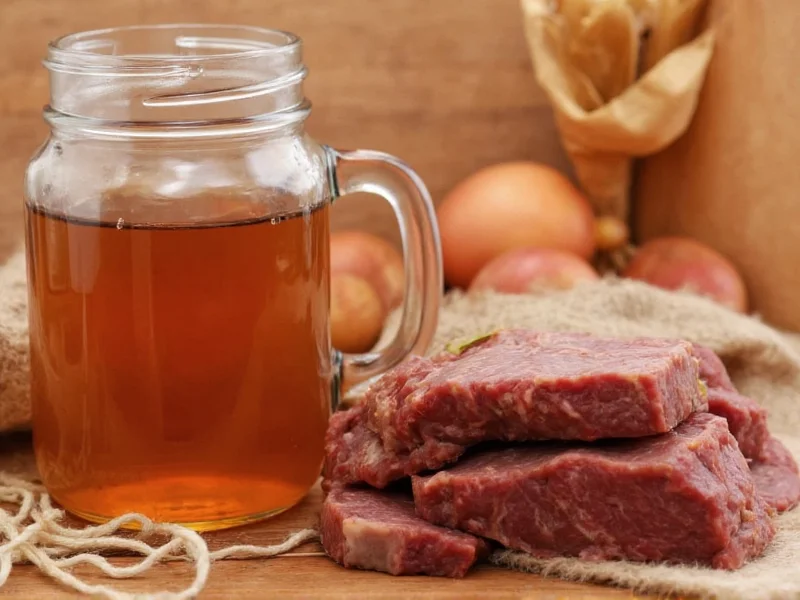When exploring the difference between beef stock and beef broth, many home cooks discover these pantry staples aren't interchangeable without affecting final dish quality. While both form the liquid foundation of countless recipes, their preparation methods, ingredients, and culinary applications create distinct characteristics that impact texture, flavor development, and overall dish structure.
What Exactly Is Beef Stock?
Beef stock represents the culinary foundation built from bones—typically roasted first to develop flavor through the Maillard reaction. Professional kitchens use marrow bones, knuckle bones, and oxtail, which contain abundant collagen. During the extended simmering process (minimum 6 hours, often up to 24), this collagen breaks down into gelatin, creating that signature rich mouthfeel that sets beef stock apart from broth.
The extended cooking time serves a dual purpose: extracting maximum gelatin while allowing impurities to rise to the surface for skimming. This careful process yields a liquid that, when chilled, should congeal slightly due to the gelatin content—a hallmark of properly made stock. Chefs rely on this gelatin-rich beef stock as the base for sauces, gravies, and dishes where body and texture matter as much as flavor.
Understanding Beef Broth Composition
Beef broth takes a different approach, prioritizing immediate flavor over structural properties. It's made with a higher ratio of meat to bones, often incorporating trimmings and scraps that would otherwise go to waste. The shorter cooking time (2-4 hours) preserves the direct meat flavor without extracting significant collagen.
This quick preparation beef broth delivers pronounced savory notes right from the start, making it ideal for soups and stews where the liquid itself is part of the eating experience. Commercial broth products often contain additional seasonings and salt, creating that familiar 'ready-to-consume' flavor profile many associate with canned products.
Key Differences at a Glance
| Characteristic | Beef Stock | Beef Broth |
|---|---|---|
| Primary Ingredients | Bones (70-80%),少量 meat, mirepoix | Meat (60-70%), some bones, mirepoix |
| Cooking Time | 6-24 hours | 2-4 hours |
| Gelatin Content | High (congeals when chilled) | Low (remains liquid when chilled) |
| Flavor Profile | Subtle, foundational, rich in mouthfeel | Immediate, pronounced meat flavor |
| Primary Culinary Use | Sauces, reductions, dishes needing body | Soups, stews, sipping broths |
| Salt Content | Typically unsalted | Often pre-salted |
When to Choose Stock Over Broth (and Vice Versa)
Understanding when to use beef stock instead of broth separates amateur cooks from professionals. Reach for stock when making pan sauces, demi-glace, or any dish where the liquid reduces significantly—its gelatin content creates luxurious texture without additional thickeners. The professional technique of "mounting with butter" works best with stock due to its neutral flavor profile.
Choose broth when the liquid remains a prominent component of the dish, such as in French onion soup or pho. The immediate flavor impact of broth shines in these applications. Many chefs actually combine both—using stock as the base and finishing with broth for flavor enhancement.
Substitution Guidelines: Can You Swap Them?
The question "can I substitute beef broth for beef stock" requires careful consideration. In soups and stews where liquid volume remains relatively constant, substitution works with minor adjustments. However, for sauces, reductions, or dishes relying on gelatin for texture, substitution creates noticeable differences.
If substituting broth for stock, consider adding unflavored gelatin (1 teaspoon per cup) to restore body. When using stock in place of broth, you'll likely need to increase seasoning since stock contains less immediate flavor. Never substitute canned broth for homemade stock in delicate sauces—the additional seasonings and preservatives can throw off flavor balance.
Homemade vs. Store-Bought Considerations
Commercial beef broth products often mislabel their products—many "stocks" are actually broths with added gelatin. True homemade stock requires time but delivers unmatched quality. For home cooks short on time, look for products specifically labeled "bone broth" which more closely resembles traditional stock.
When evaluating store-bought options, check the ingredient list: authentic stock should list bones as the primary ingredient with minimal additives. Avoid products containing yeast extract or excessive sodium if you plan to reduce the liquid significantly. The best beef broth for cooking applications maintains clean flavor without overpowering seasonings.
Common Misconceptions Clarified
Many believe the terms are completely interchangeable—a dangerous assumption in professional cooking. Another misconception suggests stock is always superior; in reality, each has specific applications where it excels. The nutritional differences between stock and broth also matter: stock contains more collagen-derived nutrients, while broth provides more immediate amino acids from meat proteins.
Understanding these distinctions transforms your cooking. That restaurant-quality sauce you've struggled to replicate? It likely started with proper stock, not broth. The next time you consider beef stock vs beef broth for soup, remember: stock builds structure, broth delivers flavor.











 浙公网安备
33010002000092号
浙公网安备
33010002000092号 浙B2-20120091-4
浙B2-20120091-4